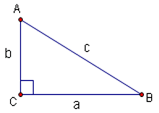Trigonometric identities
Trigonometric identities are used to manipulate trig equations in certain ways. Here is a list of them:
Contents
Basic Definitions
The six basic trigonometric functions can be defined using a right triangle:

The six trig functions are sine, cosine, tangent, cosecant, secant, and cotangent. They are abbreviated by using the first three letters of their name (except for cosecant which uses ![]() ). They are defined as follows:
). They are defined as follows:
Reciprocal Relations
From the last section, it is easy to see that the following hold:
Another useful identity that isn't a reciprocal relation is that ![]() .
.
Pythagorean Identities
Using the Pythagorean Theorem on our triangle above, we know that ![]() . If we divide by
. If we divide by ![]() we get
we get ![]() which is just
which is just ![]() . Dividing by
. Dividing by ![]() or
or ![]() instead produces two other similar identities. The Pythagorean Identities are listed below:
instead produces two other similar identities. The Pythagorean Identities are listed below:
(Note that the second two are easily derived by dividing the first by ![]() and
and ![]() )
)
Angle Addition/Subtraction Identities
Once we have formulas for angle addition, angle subtraction is rather easy to derive. For example, we just look at ![]() and we can derive the sine angle subtraction formula using the sine angle addition formula.
and we can derive the sine angle subtraction formula using the sine angle addition formula.
 ||
|| 
 ||
|| 
 ||
|| 
We can prove ![]() easily by using
easily by using ![]() and
and ![]() .
.
![]()
![]()
![]()
![]()
Double Angle Identities
Double angle identities are easily derived from the angle addition formulas by just letting ![]() . Doing so yields:
. Doing so yields:
![]() 2\sin \alpha \cos \alpha$$ (Error compiling LaTeX. Unknown error_msg)\cos 2\alpha = \cos^2 \alpha - \sin^2 \alpha$$ (Error compiling LaTeX. Unknown error_msg)=2\cos^2 \alpha - 1$$ (Error compiling LaTeX. Unknown error_msg)=1-2\sin^2 \alpha$$ (Error compiling LaTeX. Unknown error_msg)\tan 2\alpha
2\sin \alpha \cos \alpha$$ (Error compiling LaTeX. Unknown error_msg)\cos 2\alpha = \cos^2 \alpha - \sin^2 \alpha$$ (Error compiling LaTeX. Unknown error_msg)=2\cos^2 \alpha - 1$$ (Error compiling LaTeX. Unknown error_msg)=1-2\sin^2 \alpha$$ (Error compiling LaTeX. Unknown error_msg)\tan 2\alpha ![]() \frac{2\tan \alpha}{1-\tan^2\alpha}
\frac{2\tan \alpha}{1-\tan^2\alpha} ![]() \cos 2\alpha = 2\cos^2 \alpha - 1
\cos 2\alpha = 2\cos^2 \alpha - 1 ![]() \cos \alpha
\cos \alpha ![]() \cos \alpha =\pm \sqrt{\frac{1 + \cos 2\alpha}2}
\cos \alpha =\pm \sqrt{\frac{1 + \cos 2\alpha}2}![]() \alpha
\alpha ![]() \cos 2\alpha = 1 - 2\sin^2 \alpha
\cos 2\alpha = 1 - 2\sin^2 \alpha ![]() \tan \frac x2 =\frac{\sin \frac x2}{\cos \frac x2} $and plug in the half angle identities for sine and cosine.
\tan \frac x2 =\frac{\sin \frac x2}{\cos \frac x2} $and plug in the half angle identities for sine and cosine.
To summarize:$ (Error compiling LaTeX. Unknown error_msg) \sin \frac{\theta}2 = \pm \sqrt{\frac{1-\cos \theta}2} $$ (Error compiling LaTeX. Unknown error_msg) \cos \frac{\theta}2 = \pm \sqrt{\frac{1+\cos \theta}2} $$ (Error compiling LaTeX. Unknown error_msg) \tan \frac{\theta}2 = \pm \sqrt{\frac{1-\cos \theta}{1+\cos \theta}} ![]() \sin (-\theta) = -\sin (\theta) $$ (Error compiling LaTeX. Unknown error_msg)\cos (-\theta) = \cos (\theta) $$ (Error compiling LaTeX. Unknown error_msg)\tan (-\theta) = -\tan (\theta) $$ (Error compiling LaTeX. Unknown error_msg)\csc (-\theta) = -\csc (\theta) $$ (Error compiling LaTeX. Unknown error_msg)\sec (-\theta) = \sec (\theta) $$ (Error compiling LaTeX. Unknown error_msg)\cot (-\theta) = -\cot (\theta) $==Prosthaphaeresis Identities==
(Otherwise known as sum-to-product identities)
\sin (-\theta) = -\sin (\theta) $$ (Error compiling LaTeX. Unknown error_msg)\cos (-\theta) = \cos (\theta) $$ (Error compiling LaTeX. Unknown error_msg)\tan (-\theta) = -\tan (\theta) $$ (Error compiling LaTeX. Unknown error_msg)\csc (-\theta) = -\csc (\theta) $$ (Error compiling LaTeX. Unknown error_msg)\sec (-\theta) = \sec (\theta) $$ (Error compiling LaTeX. Unknown error_msg)\cot (-\theta) = -\cot (\theta) $==Prosthaphaeresis Identities==
(Otherwise known as sum-to-product identities)
- $ (Error compiling LaTeX. Unknown error_msg)\sin \theta \pm \sin \gamma = 2 \sin \frac{\theta\pm \gamma}2 \cos \frac{\theta\mp \gamma}2
 \cos \theta + \cos \gamma = 2 \cos \frac{\theta+\gamma}2 \cos \frac{\theta-\gamma}2
\cos \theta + \cos \gamma = 2 \cos \frac{\theta+\gamma}2 \cos \frac{\theta-\gamma}2 \cos \theta - \cos \gamma = -2 \sin \frac{\theta+\gamma}2 \sin \frac{\theta-\gamma}2$== Law of Sines ==
\cos \theta - \cos \gamma = -2 \sin \frac{\theta+\gamma}2 \sin \frac{\theta-\gamma}2$== Law of Sines ==
{{main|Law of Sines}} The extended [[Law of Sines]] states
- $ (Error compiling LaTeX. Unknown error_msg)\frac a{\sin A} = \frac b{\sin B} = \frac c{\sin C} = 2R.$== Law of Cosines ==
{{main|Law of Cosines}} The [[Law of Cosines]] states
- $ (Error compiling LaTeX. Unknown error_msg)a^2 = b^2 + c^2 - 2bc\cos A. $== Law of Tangents ==
{{main|Law of Tangents}} The [[Law of Tangents]] states
- $ (Error compiling LaTeX. Unknown error_msg)\frac{b - c}{b + c} = \frac{\tan\frac 12(B-C)}{\tan \frac 12(B+C)}.
 |1-e^{i\theta}|=2\sin\frac{\theta}{2}$
|1-e^{i\theta}|=2\sin\frac{\theta}{2}$









